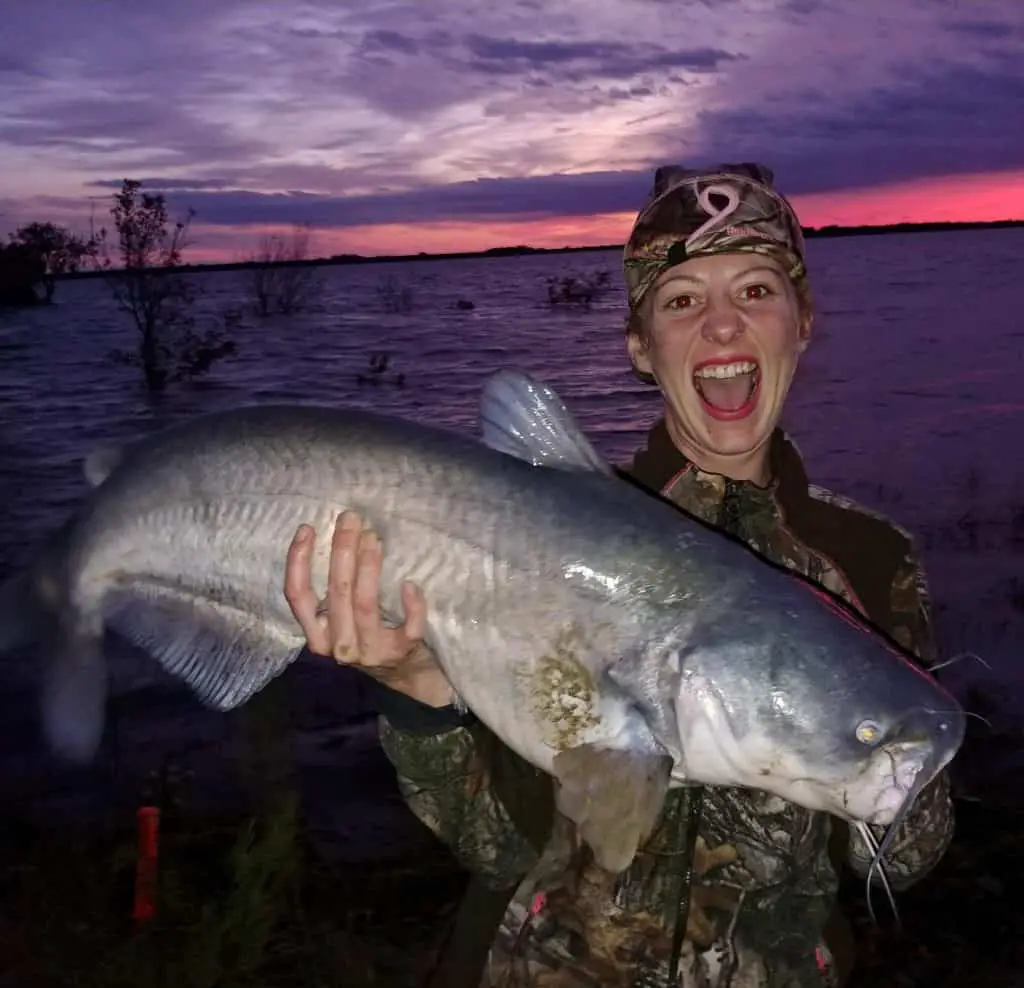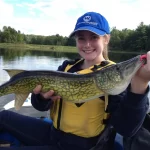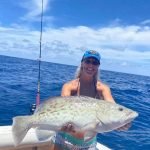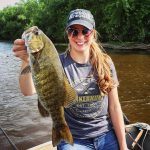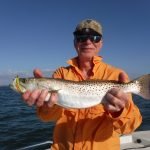Fishing for Catfish, Best Rigs and Baits for catching the top 3 catfish species
This article on fishing for catfish, best rigs and baits will help anglers catch more of these popular freshwater game fish. Catfish are growing in popularity as a game fish in North America every year. There are several reasons for this. Catfish are widely distributed and are available to most anglers in the United States. Catfish grow very large, up to and over 100 pounds. They are fairly reliable in terms of behavior and habitat and not overly difficult to hook. Catfish put up a great battle. Finally, they are fantastic eating!

Three different catfish species dominate lakes, rivers, and streams in North America. These are the channel catfish, blue catfish and flathead catfish. At least one species is available in every state throughout the lower 48. While there are many other species of bullhead that are fun to catch and quite tasty, this article will focus on the larger catfish species that are regarded as game fish.
check out my post on the best freshwater fishing tackle and lures
While catfish are taken occasionally by anglers using artificial lures, the vast majority of catfish are caught by anglers using live, natural, or prepared baits. Catfish have a keen sense of smell and use their barbells to help locate food. Catfish are opportunistic feeders, however they have had a bad reputation in the past for feeding indiscriminately on anything that they find.

The truth is that catfish are apex predators. In most instances, they prefer live prey. This is especially true with blue catfish and flathead catfish. One element that does make catfish so successful is the fact that they are very adaptable in their diet. They will feed on insects, worms, crustaceans, mollusks, amphibians, and other fish.
Best catfish fishing tackle
Tackle for fishing for catfish varies depending on the size of the fish being targeted. For most serious catfish anglers, medium heavy conventional tackle is the best choice. Landing a large blue catfish or flathead catfish near heavy cover will requires some stout tackle. A 7 foot medium heavy rod with a matching conventional reel spooled up with 40-60 pound braided line is a good all-around combination. Anglers can read more about catfish fishing tackle here. Abu Garcia offers an excellent combo for $100.
Click on the Amazon link to purchase this recommended Abu Garcia Catfish conventional outfit.

Spinning tackle can certainly be used, especially for anglers targeting smaller channel catfish. 7 foot to 8 foot spinning rods matched with 4000 series reels spooled up with 25 pound braided line work well in multiple applications when targeting catfish. This outfit is light enough to enjoy the fight of a 5 pound channel cat while still giving an angler a chance should they hook a trophy catfish. Below is a nice catfish rod and Penn 4000 reel for $85.
Click these links to shop Amazon for a 7′ catfish rod and Penn 4000 reel
“Fishing Lido Key is a participant in the Amazon Services LLC Associates Program, an affiliate advertising program designed to provide a means for sites to earn advertising fees by advertising and linking to Amazon”
Catfish fishing rigs
For the most part, catfish are bottom feeders. They are built to cruise along on the bottom and forage for food. Therefore, anglers targeting catfish do well to present their baits on the bottom. Anglers can use different types of sinkers and different rigs to present their baits naturally and effectively on the bottom. Experienced anglers do their rigging at home before the fishing trip. They then use special boxes to keep them neat and ready to go when needed.

Leaders rigged and ready to go!
Anglers can click this link to shop Amazon for pre-made catfish rigs
Probably the most commonly used and effective catfish fishing rig is a sliding sinker rig or “Carolina rig”. This rig employs a sinker with a hole in the center. A swivel is tied onto the end of the running line. A leader is then used between the swivel and the hook. This allows the bait to move naturally in the current. It also lets the catfish pick up the bait and move off a bit without feeling the resistance of the sinker.

Top rig: sliding sinker rig with no-roll sinker Bottom rig; sliding sinker rig with float and rattle
The other commonly used rig is a “spreader” rig, also known as a “chicken rig” in the South. This rig suspends baits up off the bottom. Where legal, multiple hooks can be used to cover the bottom few feet of the water column. Most anglers using a spreader rig use a bank sinker.

A 3 way rig is very similar, but only uses one leader and hook. It works very well when fishing in current. The dropper leader to the sinker is usually lighter line. That way if the sinker snags, the rest of the rig can be salvaged.

Catfish sinkers
Anglers have a couple of choices when it comes to sinkers when using sliding sinker rigs. Egg sinkers have been used for many years and still work fine. However, no-roll and coin sinkers have gained in popularity of late. These sinkers lie flat on the bottom. They tend to result in less line twist and snags.
Sinker slides are a clever little device that allow anglers to change sinker size quickly and easily. It is a small plastic tube that slides on the main running line. It has a clip where the sinker can be added. This makes changing sinker weight to match the current conditions quite simple.

Whisker bomb, used for precise bait placement
Sinker weight will be determined by several factors, primarily water depth and current speed. The general rule is to use the minimum amount of weight required for the bait to reach and hold bottom. As current strength and depth of water changes, so will the required weight. Of course, anglers casting out from the bank will add distance needed to the list of fishing sinker requirements.
Leaders and hooks for catfish fishing
Leader strength and hook size will depend on the size of the bait being used and the size of the fish being targeted. An 18 inch long leader is a good all-around choice, though anglers can go longer or shorter depending on the circumstances. Shorter leaders work better and heavy current and around structure such as fallen trees. Some anglers prefer to use a longer leader, up to 5 feet long, and at a small float near the end to lift the bait up off the bottom.

Hooks come in a myriad of sizes, strength, and designs. The two most commonly used hook types are “J” hooks and circle hooks. “J” hooks have been around a long time and are your basic stout short shank live bait hooks. Circle hooks have become more popular of late. There is evidence to show that circle hooks result in more fish being hooked in the mouth, reducing catfish mortality.
A #1/0 or #2/0 short shank live bait hook or a #5/0 circle hook are good choices for anglers targeting channel catfish and using smaller baits such as nightcrawlers. A larger #5/0 live bait hook or #8/0 circle hook is a better choice for anglers targeting larger fish with larger baits. It is a tad confusing, but sizing for “J” hooks and circle hooks is a bit different.

Advanced catfish bottom rigs
While the simple slider and spreader rigs catch plenty of catfish, experienced anglers and those fishing tournaments have a few extra tricks to enhance their presentation. A Whisker Bomb is used when precise bait placement is desired. The weight right at the hook eliminates the bait swinging back on a leader.

Other devices can be placed inline between the hook and the swivel. These add flash and action and float the bait up off of the bottom. Demon Dragon and Whisker Wobbler are two examples of this. Leader lengths vary to get the bait up off of the bottom the desired amount.
Best fishing baits for catfish
As previously mentioned, catfish have a varied diet. This ability to adapt to a number of forage sources is a key element in their prolific numbers. Catfish fishing baits can be broken down into several categories; live bait, cut bait, and prepared baits. Many different baits are effective and productive when targeting catfish. Most anglers try to have several different baits as every day is different and one bait may prove to be more productive than another on a given day.
The top 11 fishing baits for catfish are;
- Live nightcrawlers
- Livers, chicken and pork
- Fresh cut shad
- Fresh cut herring
- Fresh cut suckers
- Commercially prepared catfish baits
- Live minnows
- Live panfish, where legal (a trophy catfish bait!)
- Shrimp, fresh or frozen
- Crayfish, live or just the tail
- Soap, cut into squares

Live baits for catfish

Nightcrawlers are very productive live bait for catfish and just about every other freshwater species. They are easily obtained at bait shops and even larger retail stores. They are easy to keep alive as long as they are kept in a cool place. Nightcrawlers are generally threaded on and hooked through the body several times. This allows the juices to leech out into the water, helping to attract the catfish.
Live bait fish are very effective and are the baits of choice for anglers targeting trophy catfish. While channel catfish will take a large live bait, more often than not a large blue catfish or flathead catfish will be the target. Commercially raised minnows can be bought at bait shops. However, most serious trophy catfish anglers catch their own creek chubs or suckers and use those as bait. It is important to check local regulations to make sure that local laws are being obeyed.

Crawfish are another fantastic live bait for catfish. This is especially true for channel catfish, which are often found in flowing streams and small rivers. They are generally hooked through the tail and drifted naturally with the current. Crawfish can be purchased occasionally, but most are caught by anglers using traps. Small frogs, salamanders, and tadpoles are other effective live baits.
Using cut bait when fishing for catfish
Just about any fish that is an effective live bait can be just as effective when used as a cut bait. Suckers and chub minnows are prime examples. Many anglers prefer oily fish such as shad and herring. In the south, mullet are a popular cut bait for anglers targeting catfish. Again, anglers should check local regulations to ensure that the laws are being followed.
While frozen bait can be used, in most instances fresh dead bait is the best choice. This usually requires anglers to catch their own, though sometimes bait is available at local shops. Once acquired, the bait fish is either cut into strips or chunks. Both approaches are effective, it is mostly a matter of angler preference.

Anglers can also acquire catfish bait at the grocery store. Liver is an excellent catfish bait! Chicken livers work well, but pork liver stays on the hook a bit better. Is a very inexpensive bait. Shrimp are a bit more expensive, but are another excellent catfish bait. Ivory soap is an old-school catfish bait!
Prepared catfish baits
There are also commercially prepared catfish baits on the market. In days past, these were referred to as “stink baits”. That nickname was well earned as some of these baits smell awful! They are messy, though effective. There are different methods used to present these baits.
Dough balls are an age-old catfish bait. Recipes for dough balls are closely guarded secrets among catfish anglers. Most consist of flour, water, and some type of scent, with anise oil being a top choice. Dough balls are effective, but do not stay on the hook as long as some other baits.
Top 3 catfish species
While all three catfish species, channel catfish, blue catfish, and flathead catfish are similar, there are enough differences in location and feeding habits to cover all three separately.
Channel catfish
Channel catfish are by far the most widely distributed of the three catfish species. They are found throughout the United States and Canada. Channel catfish can tolerate a wide range of environments. Their ideal waters are large creeks, small to midsize rivers, and ponds and small lakes. Channel catfish average around 3 pounds with the current world record being 58 pounds. This fish was caught in Santee-Cooper reservoir in South Carolina.

Channel catfish are fairly easy to distinguish from blue catfish and flathead catfish. They have a deeply forked tail, similar to a blue catfish. However, the coloring is quite different. Channel catfish are a slate gray to olive in color with a white underbelly. Black spots are normally present, except in the largest specimens. Channel catfish also have a protruding upper jaw.
Read these channel catfish tips
Like most fish, channel catfish spawn in the springtime. They prefer water temperature of around 75 degrees. Nests are made by the male fish in in some type of structure. Rocks, rip rap, fallen timber, and undercut banks are prime spots. Once the eggs are laid, the male guards the nest.

Juvenile channel catfish feed mostly on insects. As they grow, their diet becomes very diverse. This is certainly one of the keys to the success of the species. They will feed on just about any live prey that they run across. They are also not above scavenging off the bottom.
Blue catfish
Blue catfish are normally found in larger river systems and lakes. Large river systems in the middle of the country such as the Ohio River, Missouri River, and Mississippi River all have good populations of blue catfish. They have been successfully stocked all over North America, offering anglers the chance to catch a true trophy fish.

Blue catfish are apex predators. They are very large and consume considerable amounts of prey. They are actually considered to be a problem in some areas, particularly the Rappahannock River in Virginia, where they are displacing native species. Blue catfish are commonly caught to 25 pounds but can easily exceed 100 pounds. The world record blue catfish is a 143 pound beast that was caught in Buggs Island Reservoir.
Blue catfish have a forked tail. Smaller fish can be confused with channel catfish. However, blue catfish do not have spots. Like channel catfish, most anglers consider them both a predator and a scavenger. Mature blue catfish do feed primarily on bait fish. Blue catfish spawn and similar areas to channel catfish. They often times live to be 30 years old.

A large blue catfish will put up a terrific battle. Anglers targeting a trophy fish will need to use fairly heavy gear. Most trophy blue catfish are caught by anglers using bait fish. A large live bait fish will not draw many strikes, but will attract larger fish. Fresh cut bait is extremely effective as well.
Flathead catfish
Flathead catfish also grow quite large, with the world record being 123 pounds. It was caught in the Elk City Reservoir in Kansas. They are also known as “yellow catfish”. Flathead catfish are fairly easy to distinguish from blue catfish and channel catfish. Flathead catfish are found in larger river systems throughout the middle part of the country.

As their name implies, they have a large, flat head. They are generally light yellow to light brown in color, thus the nickname “yellow catfish”. They also have a protruding lower jaw with a tail that is notched instead of being deeply forked.
Flathead catfish very significantly from blue catfish and channel catfish in their dietary habits. They feed exclusively on live bait fish. They are less opportunistic and do not scavenge on the bottom. Flathead catfish spawn a bit later in the year as well, preferring water temperatures up to 80°.

Mature flathead catfish are loners. They will stake out a prime ambush spot under a fallen tree, undercut bank, or other heavy structure. Flathead catfish prefer deeper holes and slow-moving water. They will move up into very shallow water at night to feed. While flathead catfish can be taken by anglers using cut bait, large live bait fish are preferred.
In conclusion, this article on fishing for catfish, best rigs and baits, will help anglers catch more of these terrific game fish!
